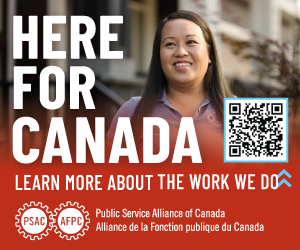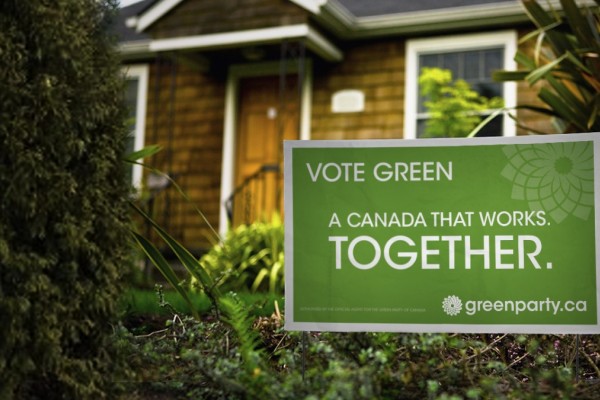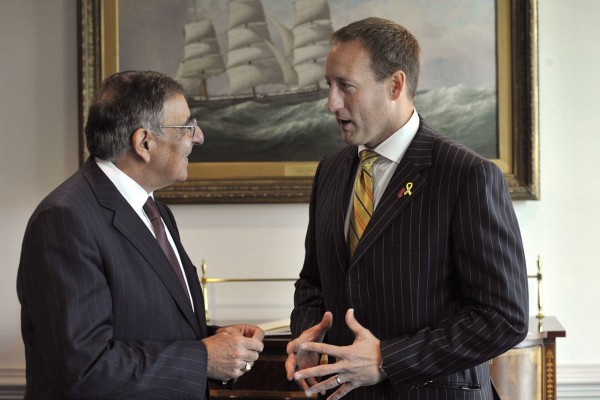Dude, where’s my bus? How the election failed public transit
Every party makes the same mistake: No challenging car culture, no operating funding

Public buses line a busy street in Ottawa. Photo by Dylan Passmore (Flickr).
We are now only days away from the federal election, with the Liberals and Conservatives locked in a neck-and-neck race for what will likely result in a minority government for the victor. Many political headlines since the writ drop in mid-September have concerned varying degrees of scandal—the Justin Trudeau brown/blackface photos and false allegations of sexual misconduct, along with Andrew Scheer’s obfuscating about his citizenship and former career and the Green Party’s over-enthusiastic use of photo editing—with only marginal attention paid to actual policy issues. Jagmeet Singh has shone at moments, highlighted by his appearance at a Vancouver picket line, but most of the past month has been a blur of predictability frivolous personality-driven squabbles among party leaders.
This trend has resulted in a complete abdication of debate (or often even mention) of some of the most serious issues facing communities across Canada: drug decriminalization and provision of a safe supply of drugs, policing and incarceration, and imperialist foreign policy among others. But it is the absence of any legitimate consideration of public transportation that is perhaps most shocking, particularly given the focus among ostensibly progressive parties on climate justice, racial and economic equality, and accessibility for seniors and people with disabilities. Across the board, every major party has failed to propose any real alternative to the crises of austerity, privatization, and inefficiency facing transit agencies in almost every city and region.
Nominal funds have been committed for various transit projects, but nothing has been committed by any parties for operations and maintenance. As Steven Higashide of New York City’s TransitCenter put it in a recent interview: “the biggest problem [with public transit] in most cities is that we don’t run enough service. You could use federal transportation funding to buy a bus, or stripe a bus lane, but you can’t use it to hire a bus operator, or dispatchers, or people who are planning bus priority projects.”
Political candidates are more than happy to pledge money if it means they will eventually be able to cut a ribbon and score a photo-op, but most completely avoid the urgent need to provide funds to actually run the systems. That’s greatly aggravated by the lack of networking and coordination at all levels of transit. I will address this after I run through what the parties are specifically promising.
Conservatives
The Conservatives are predictably deceptive on this file, promising to restore Stephen Harper’s Public Transit Tax Credit to “provide much-needed relief for transit users.” Yet the transit tax credit—which was eliminated in the 2017 federal budget—is an extremely expensive and inefficient way to promote transit ridership, costing between $229 and $308 million a year. Crucially, it systematically privileges rich residents, who are: a) able to buy a weekly or monthly transit pass; b) aware of the tax credit’s existence; and c) earning enough income to benefit fully from a non-refundable credit. Promises to fund new subway lines in the Greater Toronto Area are similarly shady, with TTCriders slamming the Ontario Line proposal for poor planning and consultation, lack of integration with the TTC, and further privatization of infrastructure. New rail infrastructure is sorely needed—but not the kind that advances right-wing politics through loss of public and democratic control over decision-making.
Liberals
The Liberals haven’t done much better on that front. Sure, the government allocated $28.7 billion over 11 years for public transit, mostly through its “Investing in Canada” Plan. But infrastructure funding is often a gameable metric, as funds are only dispersed after a project has been completed and receipts have been filed to the government. In response to the 2019 budget, the Canadian Urban Transit Association expressed concern about the uncertain future of federal transit funding beyond 2020-21: “the pace of spending under the Investing in Canada Plan has been slower than originally anticipated, for reasons that include delays between construction activity and receipt by the Government of claims for payment, and by some jurisdictions being slower to prioritize projects than expected.” A vast majority of Liberal funding for transit is backloaded until the latter half of the 2020s, meaning there is no guarantee those projects will happen.
Much of the funding that has actually been committed to public transit by the Liberals has been through its highly controversial Canada Infrastructure Bank, which invests billions in public funds to attract private capital. It is an explicit strategy to privatize infrastructure projects, which Trudeau pretended to stop in 2015 when the government removed the “P3 screen” for applicants.
In August 2018, the Canadian Infrastructure Bank announced funding of $1.3 billion in the form of a 15-year secured loan to Montreal’s Réseau express métropolitain project (REM), which has been heavily criticized for being a “real estate venture masquerading as a public transit project” that is poorly planned and emblematic of pension fund capitalism. In May, the Canadian Infrastructure Bank committed up to $2 billion for its second transit project: to help finance Metrolinx’s GO Transit expansion in the Greater Toronto Area. Like the REM, this pledge primarily benefits capitalists seeking to profit from public infrastructure projects at the expense of good planning and services for the most in need. On the same day as the announcement, the province shortlisted four private consortia to build the project: one of which included a bid team led by the embattled SNC-Lavalin (also involved in the delayed and costly Confederation Line project in Ottawa). Metrolinx is a notoriously undemocratic organization, with no elected officials on its board.
It doesn’t stop there. In government, the Liberals effectively stood by and watched as Saskatchewan lost its critical provincial intercity bus service and Greyhound pulled out of Western Canada. While the federal government offered to cover abandoned routes in a 50-50 cost-sharing arrangement, it relied on inadequate excuses blaming provincial jurisdiction to evade responsibility for funding a genuinely public and properly coordinated intercity system. The fallout of the loss from these bus services, compounded by Via Rail’s structural inability to provide reliable service, has been unequivocally catastrophic. Last week, Amalgamated Transit Union (ATU) Canada published a radio documentary and petition calling on the next federal government to operate a national system.
Greens
Somewhat surprisingly, the Greens have a fairly weak platform when it comes to transit. Its National Transportation Strategy commits to “zero-carbon public ground transportation everywhere in Canada by 2040,” with sensible recognition of the “hub-and-spoke” approach to networking buses and trains and the need to build childcare along transit routes. Last week, the party tweeted: “Greens ♥ high-speed, electric trains.” The Green platform even cites a report about clean energy jobs, reporting that 171,000 of the 298,000 clean energy jobs in Canada were reported to be in transportation, “mostly public transit.”
Yet its fully costed platform doesn’t even mention urban transit, let alone commit specific funding to it. The party has pledged to institutionalize and double federal transfers to municipalities in the form of a Municipal Fund, replacing the Gas Tax Fund, but that approach fails to specifically carve out money for transit (which can result in other projects like roads for automobiles sucking up much of the money). Meanwhile, biking and walking are allocated $100 million a year—which is not much help to many people in winters, particularly those with mobility constraints. Even its allocations for national passenger rail only reach $720 million per year by 2023-24: for context, Via Rail has estimated that it will cost a total of $4 billion to build dedicated tracks for its “high frequency rail” service between Toronto and Quebec City. High-speed rail between Calgary and Edmonton, another project that it has identified as a priority, is estimated to cost between $6 and $10 billion. It’s one thing to ♥ electric trains, and quite another thing to properly fund it. Meanwhile, the Greens only committed $10 million a year to support rural bus transportation, well below what’s required to provide anything close to universal access.
As with every other party, the Greens have failed to commit any funding to operations of public transportation. That means that it would help a municipality or province/territory buy an electric bus, but not pay to actually run it.
NDP
The NDP has fallen into the exact same trap. To be sure, it made the somewhat courageous promise to “build a path towards fare-free transit” for “provinces and municipalities that identify it as a priority.” Fare-free transit is a globally renowned policy to help boost ridership, improve access for poor households, and gets drivers out of cars. But it’s completely unclear how much money the party is willing to put towards such a goal, particularly given that it has only pledged $1.45 billion a year in total for “clean transit and transportation” (the TTC received $1.2 billion in revenue from passenger fares in 2017). Likewise, the NDP committed to re-establishing bus routes abandoned by Greyhound and expanding service in rural areas, without indicating how much would be spent and whether such a system would be public or privately contracted/subsidized. The promise to electrify transit and build high-frequency rail is all well and good—but the dollars simply aren’t there, and don’t address the fundamental issue of operating spending.
Instead of platforming transit as a pivotal issue to confront climate change and economic inequality, Singh made the peculiar choice of promising to bring back a $300-million “automotive innovation strategy” for automakers who manufacture electric vehicles in Canada—announced outside the GM plant in Oshawa, which local union activists have called to be nationalized (the NDP ignored that demand). He also pledged to increase the government rebate for people who purchase electric vehicles from $5,000 to $15,000 if the vehicle was made in Canada. A recent analysis by the U.S. Congressional Research Service indicated that 78 percent of the electric vehicle tax credits claimed in 2016 were by filers with an adjusted gross income of $100,000 or more. Like with all other parties, the NDP has treated transit as one of many infrastructure priorities in need of federal funding without doing the actual work of understanding why transit systems in most parts of Canada are failing or effectively non-existent.
Moving forward
The main answer as to why public transit has lagged behind in Canada is somewhat unpopular: good transit and good automobile access cannot co-exist. It’s a zero-sum game. Every automobile on the road adds traffic congestion, danger to pedestrians and cyclists, and demand for more investment in roads and highways. It’s why the strategy presented by most parties that fund both personal electric vehicles and public transit is a dead end. We can and should have highly reliable, frequent, and comfortable transportation systems in urban, rural, and intercity contexts—but that means the taking away of space from private vehicles through dedicated transit lanes and outright bans in certain parts of cities. No political party has been willing to even broach this subject.
Aside from reductions in greenhouse gases and air pollution, electric vehicles replicate all the same crises that automobility has produced for a century: incredible spatial inefficiency, deeply regressive financial and legal impacts on poor households, deadly impacts on other street users, and lack of accessibility for seniors and people with disabilities. Extremely expensive rail projects like subways and elevated light rail have been deployed by politicians too afraid to confront the automotive lobby and rich residents, who have opted to build transit that fails to impede car access and thus limits the possibility of rapid change. The only solution from the level of the federal government is to withdraw funding for new highways, roads, and automotive subsidies, replacing them and expanding spending for transit.
There’s the other key aspect to this struggle: beating back capitalist austerity. A far more effective emissions reduction strategy for a progressive party to pursue, in lieu of buying up a bunch of electric buses that sit idle for much of the day, would be to commit large amounts of federal dollars to operating expenses, allowing transit agencies to run far more buses throughout the day (even if those buses are currently running on diesel). Most transit agencies cut back service during evenings and weekends, when many low-wage workers still need to use the system. People also require reliable transportation for many other needs other than commuting to work: going to grocery stores, medical appointments, school, socializing, and religious events. Failing to provide good transit for all those needs results in transit riders often being forced to buy an automobile. Running better service means more ridership—and far lower per-capita emissions.
The solution to this crisis is money. But austerity isn’t just about funding: it’s about the wrenching away of local democracy. Politicians should help lead the charge against ongoing privatization and Metrolinx-like secrecy, which always ends up benefiting capitalists. While reallocating funding from automobility to transit, progressive leaders must prioritize both the expropriation and construction of genuinely public transportation bodies that are democratically accountable and focused on providing universal access for everyone regardless of income and ability. Centrally owned and operated transportation agencies, like a national intercity bus service, lead to greater coordination and opportunity for people to travel through several regions or even provinces with ease.
These are not complicated policy issues. Stop subsidizing automobility, start properly funding transit, and commit to making transportation genuinely public and coordinated. None of the parties have fought for this. It’s deeply disappointing, and leaves much for transit rider organizations and transit unions to do on their own.
James Wilt is a freelance journalist and graduate student based in Winnipeg. He is a frequent contributor to CD, and has also written for Briarpatch, Passage, The Narwhal, National Observer, Vice Canada, and the Globe and Mail. James is the author of the recently published book, Do Androids Dream of Electric Cars? Public Transit in the Age of Google, Uber, and Elon Musk (Between the Lines Books). He organizes with the police abolitionist organization Winnipeg Police Cause Harm. You can follow him on Twitter at @james_m_wilt.










